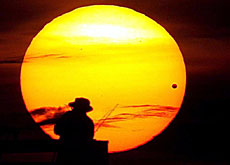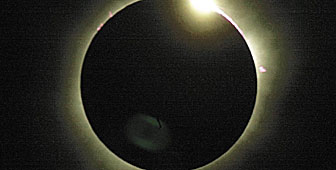Venus beats a path across the Sun’s face

Swiss astronomers have pointed their telescopes towards the sky for a six-hour event that has not been seen for 122 years.
On Tuesday the planet Venus inched its way across the Sun for the first time since 1882.
The planet – which appeared as a tiny black dot – moved across the lower half of the Sun. It will cross the upper half eight years from now in 2012.
The event will then not happen again for 105 years.
Like people all around the world, hundreds of Swiss made the most of the fine weather and turned up at observatories to see the six-hour phenomenon through telescopes.
Transits of Venus can be observed when the Sun, the Earth and its sister planet precisely line up.
Such transits have taken place only six times since the invention of the telescope.
Scientific experiments
Astronomers at the Federal Institute of Technology in Zurich used the transit to conduct experiments as part of ongoing efforts to develop a new generation of telescopes.
Head astronomer Jan Olof Stenflo described the occasion an “an ideal opportunity” to test an instrument which can measure subtle patterns of scattered light emitted by Venus during the crossing.
He hopes that such a device may be used in future to discover planets millions of light years away.
“It is difficult to find planets because the light from stars is a million times brighter. Light from a planet leaves its own signature. We are watching Venus to test our instrumentation,” Stenflo told swissinfo.
But he added that the transit of Venus was of historical as well as scientific significance.
Mapping the universe
In the 18th and 19th centuries, astronomers attempted to map the universe by measuring the distance between the Sun and Earth during such transits.
The distance to the Sun was calculated to be 149.3 million kilometres, just 0.3 million less than the figure accepted by the scientific community today.
The transit of Venus in 1769 was tracked by a joint team of European scientists who discovered that the planet had its own atmosphere.
In 1874, Russia, Britain, the United States, France, Germany, Italy and Holland all sent teams of scientists to observe and record the event.
“It was the 19th century equivalent of the space race,” said Steven Dick, chief historian for the US National Aeronautics and Space Administration.
swissinfo, Elizabeth Meen
There have been only six transits in the telescopic age – in 1631, 1639, 1761, 1769, 1874 and 1882.
The Federal Health Office warned against looking directly at the planet as it moves across the Sun.
The six-hour transit was visible across the globe, except for the western United States, south-western Canada and the southern tip of South America.
In Switzerland, the spectacle ended at around 1:20pm.
Transits of Venus were used to measure the distance to the Sun.
The scale of the solar system was calculated by mathematical formulae and based on data collected by astronomers across the world.
Complete accuracy was impeded by atmospheric distortions and limited technology.
The next transits will occur in 2012, 2117 and 2125.

In compliance with the JTI standards
More: SWI swissinfo.ch certified by the Journalism Trust Initiative

You can find an overview of ongoing debates with our journalists here. Please join us!
If you want to start a conversation about a topic raised in this article or want to report factual errors, email us at english@swissinfo.ch.